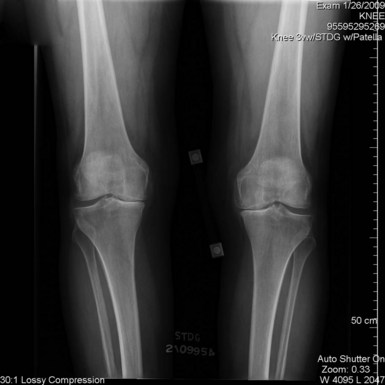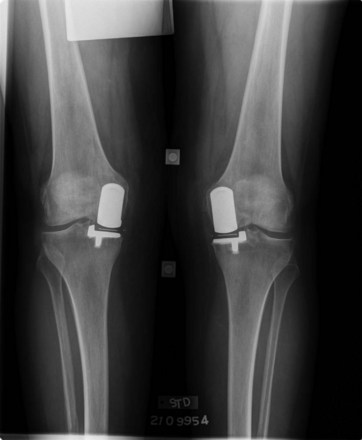CHAPTER 31 Bilateral Unicompartmental Knee Arthroplasty
 Bilateral unicompartmental arthroplasty is a safe option for select patients with bilateral unicompartmental arthritis.
Bilateral unicompartmental arthroplasty is a safe option for select patients with bilateral unicompartmental arthritis.Introduction
Knee arthroplasty procedures have become a reliable, long-term solution for disabling knee pain, and have begun to be used in an increasingly younger patient population. The number of unicompartmental arthroplasties of the knee has increased at a rate of 32.5% annually over the last few years.1,2 This procedure has emerged as an attractive alternative to total knee arthroplasty for many arthroplasty surgeons, when used in the proper surgical setting, as it spares more bone, is associated with better knee kinematics, provides a more rapid postoperative recovery, and potentially allows for an easier revision if needed.3–7 Bilateral unicompartmental arthroplasty is an alternative in the patient with symptomatic bilateral knee arthritis isolated to one compartment of the tibiofemoral articulation (Figs. 31–1 and 31–2). This chapter discusses the indications and outcomes of bilateral unicompartmental arthroplasty as well as the surrounding controversies limiting its widespread use, followed by the authors’ preferred method of treatment.
Rationale
There is a paucity of data on bilateral unicompartmental arthroplasties; therefore, the data on bilateral total knee arthroplasties (TKAs) could be extrapolated to the unicompartmental discussion, although clearly the morbidity and risks associated with TKA are quite different from those of unicompartmental arthroplasty. There are a myriad of studies investigating the safety of bilateral TKA. Although some authors have maintained that patient selection is quintessential to avoiding a higher complication rate, many other authors have reported an increased risk of cardiac and pulmonary complications as well as an increased postoperative 30-day mortality in the simultaneous bilateral total knee setting.8–13 In a recent meta-analysis looking at the safety of bilateral TKA, the prevalences of pulmonary embolism (PE), cardiac complications, and mortality were higher after simultaneous bilateral total knee replacement.11 In light of these known complications, some authors have stressed the importance of mitigating perioperative risk by screening for preexisting cardiac or pulmonary disease prior to proceeding with bilateral TKA.9,12–17
Although there are increased risks of complications associated with simultaneous bilateral TKA, there are certain advantages to undergoing both knee replacements under one anesthetic. Obviously, there is only one anesthetic risk and one hospital stay, which translate into a shorter cumulative stay and less overall cost. In addition, the patient undergoes symmetric rehabilitation, which may explain the better functional outcomes reported with simultaneous bilateral TKAs.11-13,18-22 Zeni et al.22 evaluated the functional outcomes of patients undergoing simultaneous bilateral TKA compared to those undergoing unilateral TKA and a healthy control group. These patients were matched for sex, age, and body mass index, and were observed prospectively for 2 years. Subjects in both surgical groups showed significant improvement in knee outcome scores, Short Form-36 physical component scores, timed up-and-go test, and stair-climbing tasks. No significant differences were seen in final outcomes between surgical groups. The authors of that study concluded that subjects medically appropriate for bilateral TKA should be given this option.
The cost-effectiveness of bilateral unicompartmental arthroplasty has not been reported in the literature, but it has been reported for bilateral TKA as well as unicompartmental arthroplasty on a single side.23 Reuben et al.21 used a hospital-based computer system to compare the inpatient costs of performing bilateral simultaneous sequential, staged, and unilateral TKAs. Bilateral simultaneous sequential TKA was 36% less costly than bilateral staged TKA. Prosthetic costs range between 28% and 43% of the total costs of hospitalization. There was a significant correlation between hospital length of stay, morbidity, and total costs, but no correlation with patient age and gender except in the unilateral knee surgery patients. The authors concluded that bilateral simultaneous sequential TKA can save more than $10,000 for each total knee replacement patient.21 With the idea of looking specifically at overall cost of bilateral unicompartmental arthroplasties at the Mayo Clinic, we reviewed 20 patients who underwent bilateral unicompartmental arthroplasty on the same day as well as in a staged fashion and compared the two groups. The increase in overall costs for the bilateral unicompartmental arthroplasty performed in a staged fashion was 37% when compared to simultaneous bilateral UKA. For the staged procedure, the cumulative operating room costs increased 20%, hospital and nursing costs 28%, and the surgeon reimbursement was increased 25% when compared to the simultaneous bilateral knee group. However, the hospital net revenue was 39% more for the staged when compared to the simultaneous procedure.
Outcomes
Very little has been published reporting the outcome of patients who have undergone bilateral unicompartmental arthroplasties. The only available study in the published literature to date compares the immediate postoperative complications of single- versus two-stage bilateral unicompartmental knee replacement.24 Chan et al. provided this retrospective look at the major complications occurring after simultaneous and staged bilateral unicompartmental arthroplasties by comparing 159 patients (318 knees) treated with one-stage and 80 patients (160 knees) treated with two-stage arthroplasty. The bilateral unicompartmental groups were comparable in age and in ASA grade. The major complications they tracked were death, PE, proximal deep vein thrombosis (DVT), and adverse cardiac events within 30 days of surgery. Major complications were seen in 13 patients (8.2%) with one-stage operations but none were encountered in the two-stage group, which reveals a statistically significant difference. The authors of that study concluded that the significantly higher risk of major complications associated with one-stage bilateral unicompartmental knee replacement should make surgeons take caution prior to undertaking such a procedure.
There were several limitations to this study that should be pointed out to the reader. No chemoprophylaxis was used in their protocol, and venous thromboembolism accounted for the majority of the complications. Ten different surgeons performed the cases, and the anesthetic protocol used was local wound infiltration in combination with general anesthesia.24 These differences may not allow for the data to be translated to North America as chemoprophylaxis is routinely used and spinal anesthesia is typically used for anesthesia. At the closed meeting of the Knee Society in 2009, Berend et al. presented a large series of patients undergoing bilateral unicompartmental knee arthroplasty. They compared 141 patients (282 knees) treated with staged partial knee arthroplasty to 35 patients (70 knees) treated with simultaneous partial knee arthroplasty to evaluate perioperative complications and short-term functional outcomes. Patients in the study who underwent simultaneous unicompartmental knee arthroplasty had a significantly shorter cumulative operative time (109 vs. 122 minutes), a shorter cumulative length of stay in the hospital (1.7 vs. 2.5 days), higher Knee Society Functional scores at most recent follow-up (87.9 vs. 72.9), and higher Lower Extremity Activity Scale scores (12.0 vs. 10.2) without a difference in perioperative complications. In the study, the simultaneous cohort was significantly younger and less obese than the staged group, which could account for some of the differences encountered in the study. The lack of difference in perioperative complications is distinctly different from the findings by Chan et al. and is likely due to the disparity in anesthetic protocols and the changes in venous thromboembolism prevention. Berend et al. used a combined spinal and general anesthetic with local wound infiltration, and all of the patients received some form of chemoprophylaxis—either aspirin, low-molecular-weight heparin, or warfarin (Coumadin)—based on preoperative risk stratification.
Stay updated, free articles. Join our Telegram channel

Full access? Get Clinical Tree










